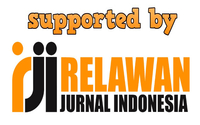THE IMPACT OF DIFFERENT SOCIAL CLASSES IN LOUISA MAY ALCOTT’S NOVEL LITTLE WOMEN
Abstract
Full Text:
PDFReferences
Abcarian, R, Marvin, K. and Peter, R. (1998). Literature: Reading and writing the human experience. New York, NY: St. Martin’s Press Inc.
Alcott, L.M. (1868). Little woman. Boston, MA: Qanita.
Barry, Peter. (1995). Beginning theory; An Introduction to literary and cultural theory. Manchester, England: Manchester United Press.
Creswell. J. W. (2003. Research design: Quantitative and mixed method approaches (3rd ed.). Thousand Oaks, CA: Sage.
Day, G. (2001). Class: The new critical idiom. London, England: Routledge
Doody, M. A. (1996). The true story of the novel. New Brunswick, N.J.: Rutgers University Pres.
Dwipayana, G., Eko, S., & Wicaksono, A. (2003). Membangun good governance di desa. Yogyakarta, Indonesia: Ire Press.
Gerard, S. (2001). The psychology and sociology of literature. Thousand Oaks, CA: Sage.
Horton, P. (1980). Social class effects. New York, NY: McGraw-Hill Companies.
Kerbo, H. (1996). Social stratification and inequality: Class conflict in historical and comparative perspective. New York, NY: McGraw-Hill Companies.
Litosseliti, L. (2010). Research methods in Linguistics. New York, NY: Continuum International Publishing Group.
Marx, K., and Engels, F. (1973). Manifesto of communist party. Moscow, Russia: Progress Publisher.
Saptono, Sulasmono, B. S., & Suteng, B. (2007). Sosiologi. Jakarta, Indonesia: PT. Phibeta Aneka Gama.
Semi, A. (1989). Kritik sastra. Bandung, Indonesia: Angkasa.
Wilczynski, J. (1984). Dictionary of marxism, socialism and communism. London, England: The Macmillan Press.
Woolf, V. (1882). Literary theory. London, England: David Carter.
DOI: https://doi.org/10.30743/jol.v7i2.11997
Refbacks
- There are currently no refbacks.
Fakultas Sastra
Universitas Islam Sumatera Utara (UISU)
Jln. Sisingamangaraja Teladan Barat Medan, Indonesia
Phone: +627869911 | e-mail: journal_language@sastra.uisu.ac.id










